Lyon (France) – the most detailed information about the city with photos. The main attractions of Lyon with a description, guides and cards.
Contents
City of Lyon (France)
Lyon – a city in eastern France and the capital of the Auvergne-Rhône region – The Alps. It is the third largest city in the country and the second largest value after paris. Lyon doesn’t often fall for tourist routes, although it has a rich history dating back centuries before the period of ancient Rome. The city has preserved a magnificent historical core, which is a UNESCO site and includes the oldest France’s ancient ruins, charming medieval streets, atmospheric areas along the rivers Sona and Rona, as well as beautiful renaissance houses. Lyon is known for its gastronomy, cultural life and as the place where cinema originated. It is here that the brothers Lumiere began the production of their cinematographs.
- Geography and climate
- Practical information
- Story
- sights
- Video
- Maps and guides
- Comments and reviews
Geography and climate
Lyon is located in the south-east of France at the confluence of the Rhone and Saone at a distance of about 400 km from Paris. The city lies on the Rhone lowland and surrounded by gardens and vineyards. From the west rises The central mountain range, and the Alps to the east. Climate temperate continental with some influence of the Mediterranean. Winters are cool, with cold winds and a minimum of snow cover. Summer is dry, hot and sunny.
 Panorama of Lyon
Panorama of Lyon
Practical information
- The population is more than 500 thousand people.
- The area is 47.87 km2.
- The language is French.
- Currency – Euro.
- Visa – Schengen.
- Time – Central European UTC +1, in summer +2.
- Festival of Lights (Fête de Lumières) – the most important event of the year in Lyon. Lasts four days from December 8th.
- The airport is located 25 km east of Lyon. Serves following directions: London, Rome, Paris, Madrid, Berlin, Brussels, Toulouse, Bordeaux.
- Lyon is connected by high-speed rail link with Paris, Brussels and Marcel.
- The city is a major transportation center and is located motorways that lead to Paris, Marseille, Grenoble, Spain, Italy, Germany and Switzerland.
- Main shopping areas: La Part-Dieu (Boulevard Vivier-Merle), Rue de la République, Rue du Président Edouard Herriot, Rue Gasparin, Rue Emile Zola, Rue des Archers, Rue du Plat.
- Traditional Lyon restaurants are called bouchons. They usually open during lunch (from 12.00 to 14.00) and dinner (from 19.30 to 22.00 Service charges are always included in the bill. Traditional local food: salade lyonnaise (green salad with bacon, croutons and poached egg), saucisson chaud (sausage in wine or on a bun), quenelle de brochet (dumplings with river fish), tablier de sapeur (marinated pieces of meat covered breadcrumbs), andouillette (minced meat sausage with mustard sauce), gratin dauphinois (cream potatoes), rognons de veau à la moutarde (calf kidney in mustard sauce), cervelle de canut (fresh cheese with garlic and greens).
Story
Lyon is one of the oldest cities in France. Already between 3 and 1 For centuries, the Gallic tribe Segusiavi organized at the confluence of the rivers Rona and Sona trade place. Later on Fourviere Hill arose fortress Lugdun. In 43 BC. settlement was captured by the Romans and became a Roman colony. Romans significantly expanded and rebuilt Lugdun. The settlement had an important commercial and military significance. Many Roman emperors were here and were born Claudius and Caracalla.
 Streets of lyon
Streets of lyon
Under the Romans, ancient Lyon flourished and was in fact the capital Gaul. The highest period of its heyday fell on the 1st and 2nd centuries AD. Among Many Roman buildings have survived to the theater, Odeon, amphitheater, aqueducts and terms. At the end of the 2nd century AD after the battle between Septimius North and Clodius Albin, the city was plundered and burned. After that, Lugdun fell into disrepair.
 Lyon
Lyon
In the 5th century, Lyon ceased to be the capital of Gaul and was captured Burgundians. In the first half of the 6th century, the city passes under control francs. At the same time, in the 6th-7th century, he experienced constant raids and robberies. Lyon began to flourish again during the reign of Charles Great. After the collapse of the Franks Empire, power over the city goes to church. In the 12th century, Lyon was divided between Germany and France on the river Saone.
Two significant religious events took place in Lyon in the 13th century. – Lyon Cathedrals. At one of them was even attempted association with the Orthodox Church. At the beginning of the 14th century Lyon was attached to the French kingdom, which was the end of power archbishops. In the 15th and 16th centuries, the city flourished thanks to commerce. In 1563 and 1574, a plague raged in Lyon, which claimed the lives of a third townspeople.
 Streets of Lyon
Streets of Lyon
During the French Revolution, Lyon sided with the opponents Convention. The townspeople opposed the Jacobins and overthrew them. dictatorship. After that, the Convention declared the city an enemy of the revolution. General Kellerman’s army laid siege to Lyon and after a brutal two month siege he was taken. October 12, 1793 was taken the decision to destroy it. Jacobins almost destroyed the old the city and killed half the population. Lyon began to revive only in the reign of Napoleon.
sights
 Old town in lyon
Old town in lyon
The old city of Lyon is its main attraction. He has more than 2000 years of history and is the object of the World UNESCO heritage. Despite the scars left on the “face of the city” after the Great French Revolution, Lyon retained unique monuments of antiquity, the Middle Ages and the new time.
Lyon’s oldest site is Fourviere Hill, where it was founded Gallic settlement and the Roman city. In the future, the city grew with east to west, occupying two more hills and the confluence of the Rhone and Sona. Four Historic District has an area of 500 hectares and will literally transfer you in the past of Lyon.
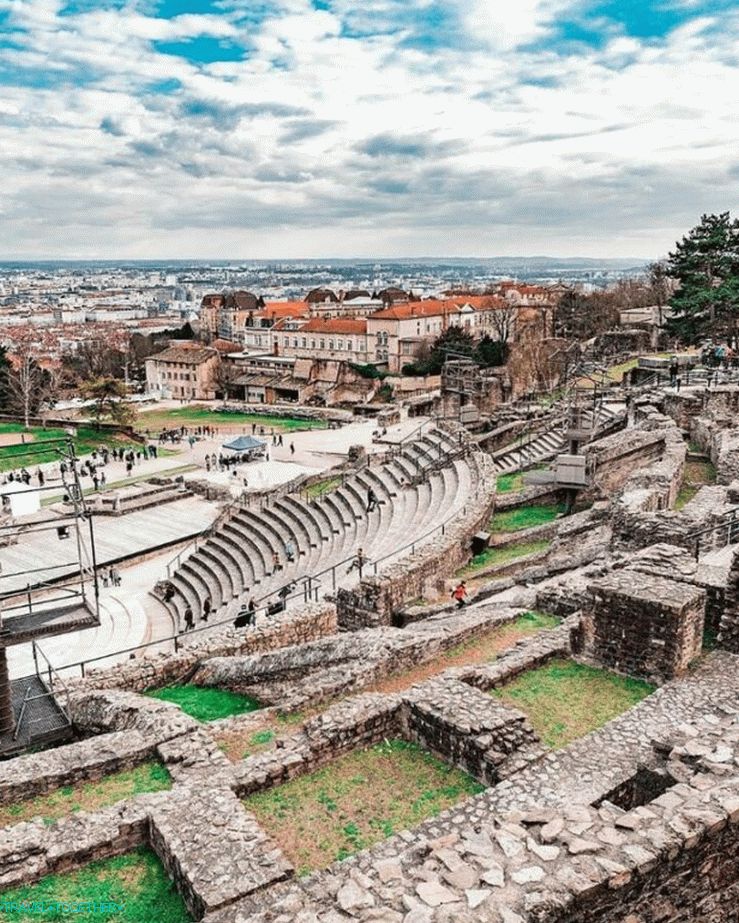 Roman theater
Roman theater
On Fourviere Hill you can find the ruins of ancient Lugdun – the capital of the Roman Gaul. Two ancient theaters are reminiscent of greatness and prosperity of the city. The Great Theater was built in the 1st century BC. and expanded in the 1st century AD The theater accommodated 10,000 spectators. Beside there is a small odeon, which the romans used to concerts and public readings. Nearby is also located archaeological museum, where all the ancient discoveries and finds
Amphitheater “Three Gallium”
Amphitheater “Three Gallium” was built in 19 AD outside Roman city and expanded on behalf of Adrian. This building used for gladiator games. Also once a year here Representatives of the Gauls gathered and pledged allegiance to Rome. The amphitheater was discovered in the 19th century.

Ancient Lugdun fed four aqueducts with water. They delivered clear water to the city from nearby mountain ranges and had the length of several tens of kilometers.
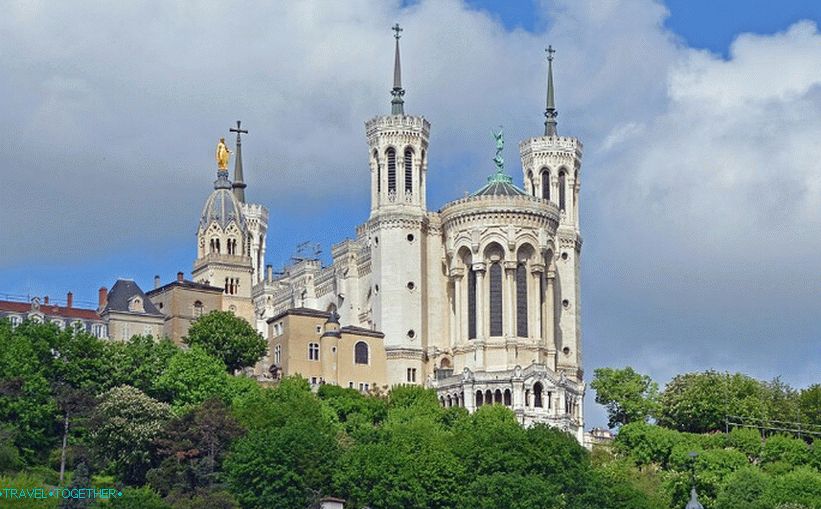 Basilica notre dame de Fourviere
Basilica notre dame de Fourviere
The Basilica of Notre Dame de Fourviere is one of the main attractions of Lyon and is located on top of the eponymous the hill above the sonna. This stunning eclectic basil was built in the 19th century after the Franco-Prussian War, when the inhabitants of Lyon swore to create a church dedicated to the Virgin Mary, if the city will be spared. The building is a mixture of Gothic and Byzantine style with a richly decorated interior. Also worth the climb for the beautiful panorama of Lyon.
 Old Lyon
Old Lyon
Between the Fourvière hill and Sonya is Old Lyon with charming renaissance lanes. These narrow streets with merchants houses of the 15th and 16th centuries preserved the atmosphere of that time when Lyon was a fairground city.
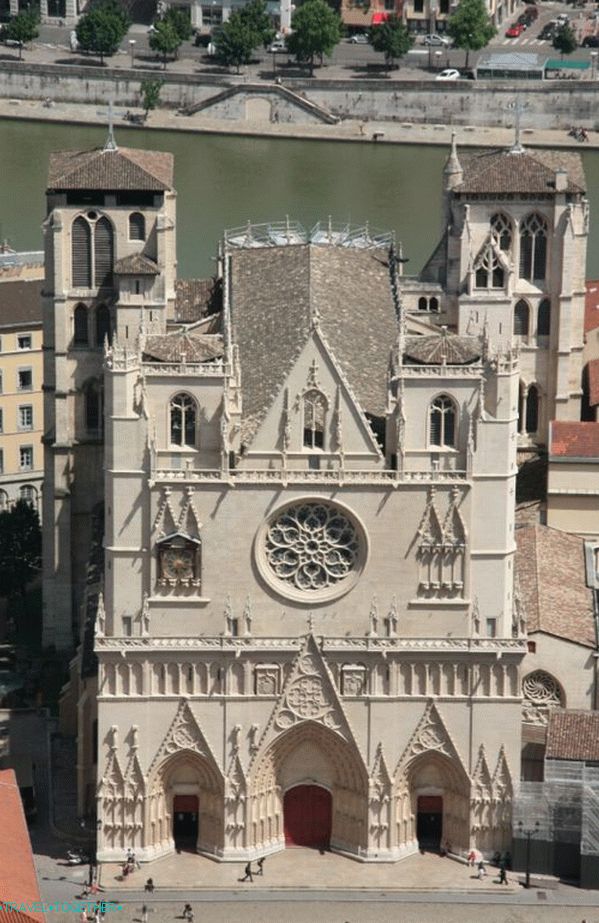
Saint-Jean-Baptiste Cathedral – a magnificent medieval cathedral Romanesque cathedral and French Gothic façade. is he It was built in the 12th century and is known for its beautiful 13th-14th-century stained glass windows. The rose window on the facade dates from the end of the 14th century, and the astronomical clock – 16th century.
 Old streets Lyon
Old streets Lyon
The medieval quarters in the area of the Saint-Jean Cathedral are one of the most charming in Old Lyon. North of the church is full charming narrow cobbled streets and quiet little courtyards. On the picturesque Place Neuve Saint-Jean square has many traditional restaurants. There are also several interesting places in this area. museums: a museum of the city’s history, a museum of cinema and miniatures, a museum dolls.
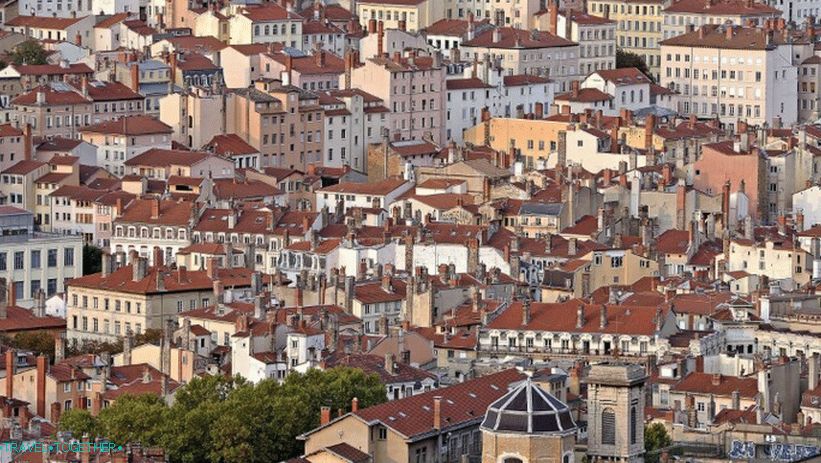 Weavers Area
Weavers Area
On the slopes of the Croix-Ruse hill there is a historical area of weavers, which was the center of the textile industry in the 19th century. This one from the most beautiful places of Lyon with many narrow side streets and charming curved stairs.
 Presqu’ile District
Presqu’ile District
The Presqu’ile district is notable for its beautiful architecture and monumental city squares. Here you can see a lot stately buildings in the Baroque and Renaissance style. In front of the town hall is the grand fountain Bartholdi. The central area of this The area is the Bellecour Square, surrounded by elegant buildings 19 century. In the center of the square there is an equestrian statue of Louis XIV.
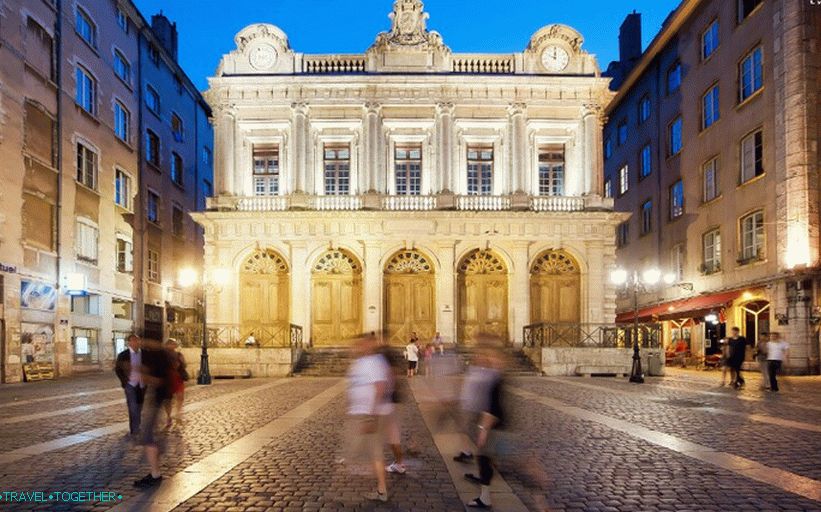 Temple of change
Temple of change
Temple of Change – a historic building of the 18th century on the project architect Jean-Baptiste Rocha. Used by Lyon merchants like a stock exchange. The building was abandoned after the revolution.
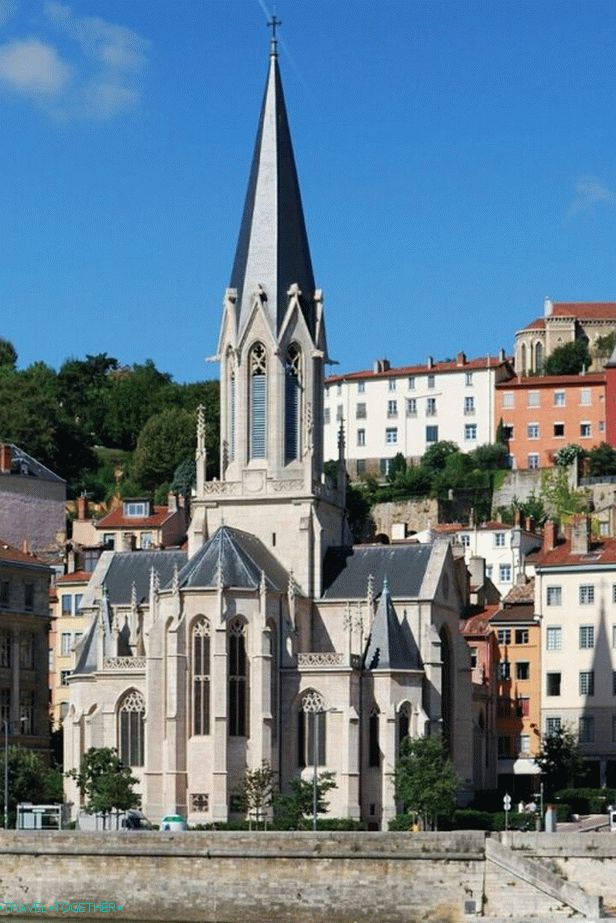 Church of sv. George
Church of sv. George
Church of sv. George – 19th century church in neo-gothic style the shore of Sona. It was built by architect Pierre Bossan and is historical monument.
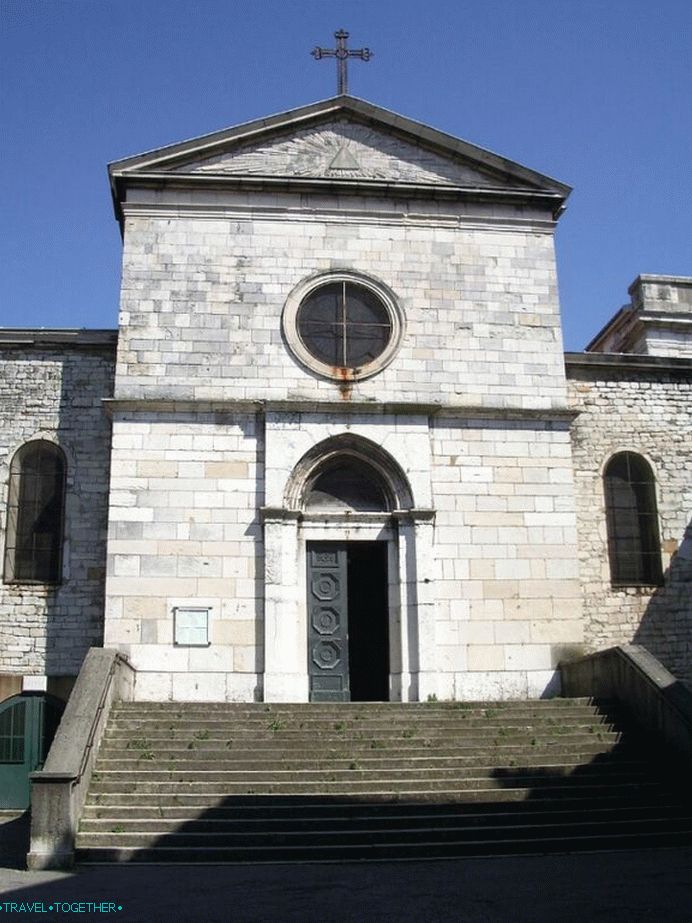
Church of sv. Iriney – 19th century church in neoclassical style, built on the site of an older religious period building Carolingian. Inside the walls of the church are preserved ancient stone sarcophagi of the roman necropolis.
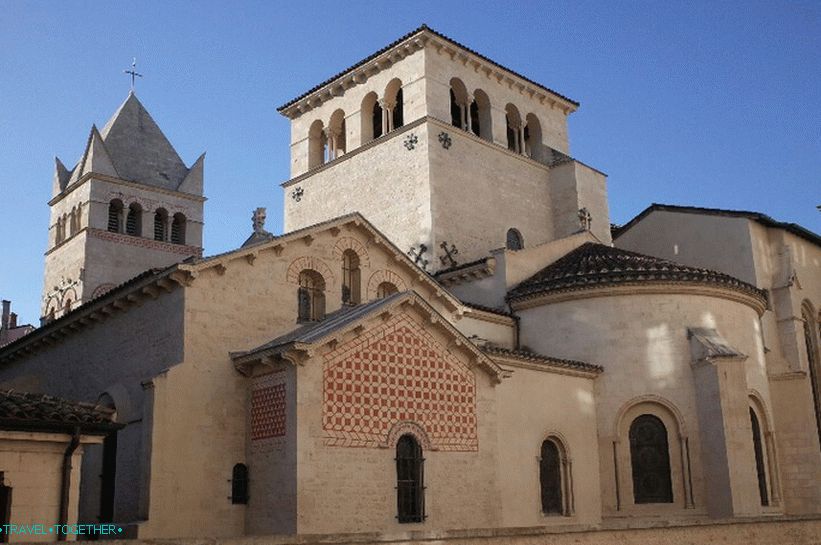 Church of sv. Martina
Church of sv. Martina
Church of sv. Martina is the only fully Romanesque church Lyon, dating from the end of the 11th century. Built on the site of an ancient church Carolingian period (9th century). Since the 13th century, the church has been part of abbey of the same name, which was closed after the Huguenot wars The church was badly damaged during the French Revolution and in the 19th century it was under threat of destruction, but fortunately was saved and reconstructed.
 Church of sv. Bonaventures
Church of sv. Bonaventures
Church of sv. Bonaventure – an old French style church gothic It was founded in 1220, rebuilt in the 14th century and at the end 15th century. The church has the most beautiful organ in Lyon and the oldest tapestries dedicated to Aubusson.
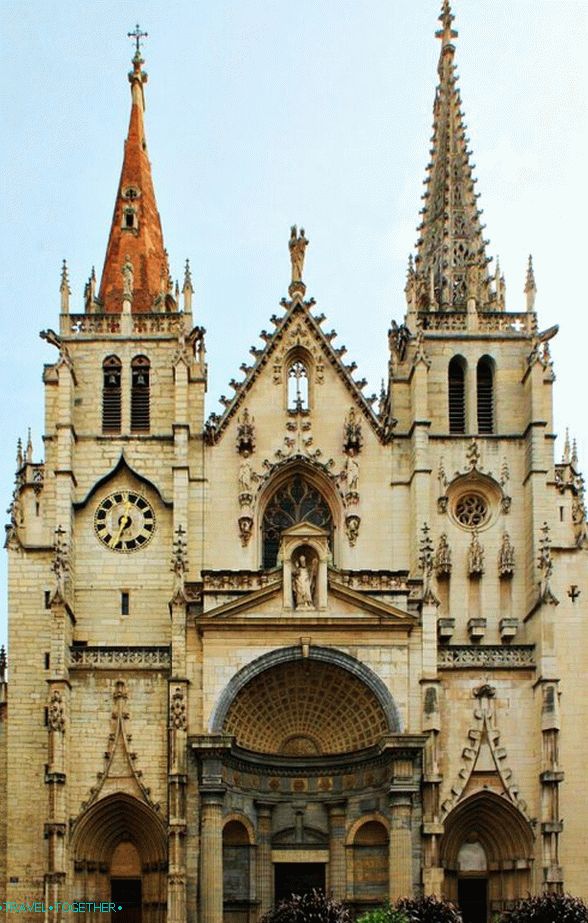 Church of sv. Nizier
Church of sv. Nizier
Church of sv. Nizier – one of the oldest religious buildings Lyon. The first church on this site was built in the 6th century. Although since the 2nd century, the first Christians gathered here. The building was rebuilt in the Gothic style between the 14th and 15th centuries.
Video
Maps and guides
Tourist Card






